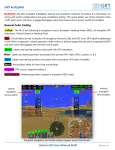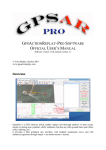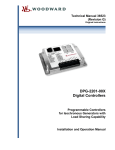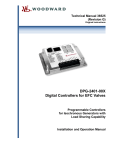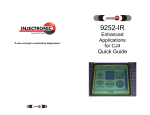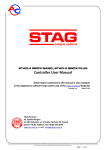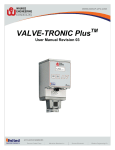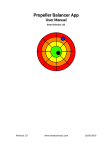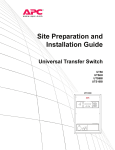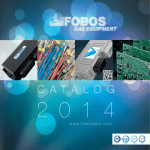Download Romano Injection System “ANTONIO” Software A.I.S.
Transcript
Software manual AIS Rev.5 del 01/10/2013 Romano Injection System “ANTONIO” Software A.I.S. – Antonio Injection System Introduction File Installation Configuration Emulation Installation Test Connection Customize Help Calibration Gas/Petrol OBDII Adaptativity Temp/Press Real-time values 1 Software manual AIS Rev.5 del 01/10/2013 Introduction The control software of new Romano ECU named “ANTONIO” presents many innovations both from ease of use point of view and from layout point of view. In fact the new software has been designed to make configuration and calibration of the system easier for installers. The new layout is very immediate and easy to use helping the installer in all his activities. When you run the program, the software interface displays the following page: The state of system DATA NOT AVAILABLE means that software hasn’t loaded data from ECU or from a configuration file yet. If ECU is properly powered and connected through serial interface to PC, when opening the program the software automatically will search out the communication port to ECU and will load all available data. When the connection stops, the state of the system will turn into CONNECTED, and the program will display the following page: 2 Software manual AIS Rev.5 del 01/10/2013 Even if the ECU isn’t connected, it’s always possible to load a configuration file already stored in memory and visualize its contents, modifying the same file if needed. All the changes will be stored in the file but not downloaded by the ECU since it is not connected. In this case the state of the system will be OFFLINE, as shown in the following screenshot: 3 Software manual AIS Rev.5 del 01/10/2013 As you can see, in the upper part of the software there is a tool bar to access the following menu: File Installation Configuration Emulations Installation Test Connection Customize Help On left side of screenshot there are some buttons to access the following menu: Calibration Gas/petrol OBDII Adaptativity Temp/Press In the lower part of screenshot there are some graphic panels and buttons which display different information when vehicle is running, such as: EngineRPM Petrol Injection Time Gas Injection Time Gas Pressure MAP Reducer Temperature Gas Temperature OBD Connection Fuel Type Display error Registration of displayed data Some of these panels have specific features, for example if you press the button “FUEL TYPE” you can switch from petrol to gas and vice versa. Or, if you press the button “DISPLAY ERROR” on gas system you will view the list of found errors; and the button REC allows the registration of working parameters. Notice also that if you double press the pressure gas panel when the vehicle is running on gas at idle speed, you will start an automatic procedure for calibration of the nominal working pressure of gas reducer. 4 Software manual AIS Rev.5 del 01/10/2013 File Through the FILE menu of access bar you can enter the submenu: Open configuration which allows to open a previously stored configuration file Save configuration which allows to save the currently displayed configuration Reprogram ECU which allows to reprogram the ECU with a specific firmware Display data capture which allows to view the working data capture already registered and stored in a file. Save data capture which allows to store in a file all functioning data as per last registration input (after pressing the button REC) Exit which allows to exit the program 5 Software manual AIS Rev.5 del 01/10/2013 Installation configuration Once installed the system, you should calibrate the ECU through the control software: Start the calibration program (AIS) by clicking on the appropriate icon Wait the connection between ECU and the computer Once they are connected (state of system CONNECTED), you should first set some information depending from the type of system and type of vehicle: From menu Installation Configuration of quick tool bar you can access the following submenus: Opening settings Guided Configuration Injection Sequence Maintenance As shown by the following picture. By selecting the submenu “ Opening setting “ you will open the following window 6 Software manual AIS Rev.5 del 01/10/2013 You will view the following initial settings page: 7 Software Manual AIS Rev.5 del 01/10/2013 As you can see in the picture, the area of system configuration is divided into 6 panels named: VEHICLE: where the installer should specify: The engine type ( Petrol Port Injection, Petrol Direct Injection ) The engine code Number of cylinders of vehicle ( 2-3-4 ) Displacement The KW power of the vehicle The type of system among the available options (standard or valvetronic / start&stop ) SYSTEM: where the installer should specify: Fuel type ( LPG or CNG) Reducer pressure ( you should set the value of gas pressure with engine runs at idle speed; this value is very important for the calibration ) The type of gas injector Used nozzle size SENSORS: where the installer should specify: The type of used level sensor The type of used reducer temperature sensor The type of used gas temperature sensor ADDITIONAL CONNECTIONS: where the installer should specify: RPM signal: Not connected if the brown wire is not connected Mono coil if the brown wire is connected and the vehicle has one bobbin for each cylinder Double coil if the brown wire is connected and the vehicle has one bobbin every two cylinders Rev counter if the brown wire has been connected directly to a source of engine revs signal Signal amplitude (to select only if revs signal has been already set): Very weak if the rev signal has an intensity ranging between 0 and 1 V Weak if the rev signal has an intensity ranging between 0 and 5 V Standard if the rev signal has an intensity ranging between 0 and 12 V or more Oxygen sensor 1: Not connected if the purple wire and the grey wire of G7 sheath are insulated Connected if the purple wire and, if emulation is needed, the grey wire of G7 sheath are connected to lambda probe. In this case, in the page “Calibration” you will have the value in tension read by ECU on Lambda sensor 1 Oxygen sensor 2 / Petrol pressure: Not connected if the purple-black wire and the grey-black wire of G8 sheath of wiring are insulated Oxygen sensor 2 if the purple-black wire and the grey-black wire of G8 sheath of wiring are connected to lambda probe. In this case in the page “Calibration” you will have the value in tension read by ECU on Lambda sensor 2 8 Software Manual AIS Rev.5 del 01/10/2013 Petrol pressure if the purple-black and grey-black wires of G8 sheath of wiring are connected to petrol pressure sensor and the white wire is connected to actuator of petrol pressure Timing advance: Present if the yellow-red wire of the G12 sheath of wiring is connected to a timing advance or to another user when running on gas. Not present if the yellow-red wire of the G 12 sheath of wiring is insulated OBD Connection: None ( Ecu has no OBD connection ) Automatic ( the ECU tries all types of connection available. On some vehicles this type of setting can turn the MIL light on so it’s always recommended to set directly the right type of used connection) ISO9141-2 if the scantool gives a connection code type 1 KWP2000 FAST if the scantool gives a connection code type 2 KWP2000 SLOW if the scantool gives a connection code type 3 CAN STANDARD 250 if the scantool gives a connection code type 6 CAN EXTENDED 250 if the scantool gives a connection code type 7 CAN STANDARD 500 if the scantool gives a connection code type 8 CAN EXTENDED 500 if the scantool gives a connection code type 9 Back solenoid valve: Connected if the ECU supplies directly the tank electrovalve Not connected if the ECU doesn’t supply directly any tank electrovalve Switchover Switchover type On Speedup if the vehicle has to switch to gas at speedup On deceleration if the vehicle has to switch to gas at deceleration Gas start if, in emergency conditions, you want the vehicle to start on gas Gas start with hot engine if you want to switch the vehicle directly to gas at idle speed when the reducer has already reached the minimum working temperature Temperature you should set the minimum temperature value of reducer to switch to gas RPM you should set the minimum value of engine rpm to switch to gas Mode Instantaneous allows to switch to gas all injectors at the same time Progressive allows to switch to gas one injector at a time Delay you set the minimum time ECU should wait from engine start before enabling the system to switch to gas (in any case the vehicle will switch to gas once it gets up all other temperature conditions and engine operating mode) Switch Back to Petrol gas finished Delay set the delay to switch back to petrol when the gas finishes Adaptativity Enabling ON if you connected the G10 sheath of wiring to OBD plug of vehicle to get an adaptative carburetion following the petrol carburetion trims 9 Software Manual AIS Rev.5 del 01/10/2013 OFF if you don’t want to use adaptativity option Petrol trims Standard Type ( carburetion is poor with positive petrol trims) + indicates poor mixture – indicates rich mixture Inverted Type (carburetion is poor with negative petrol trims ) + indicates rich mixture – indicates poor mixture Pressing the button CLOSE you can quit the vehicle configuration area and store set up data in the ECU. By selecting the submenu “ Guided Configuration “ you will open the following window: Through this window, by clicking the button “ Start “, it’s possible to start the “self-calibration” procedure of the vehicle where the software will help the user step by step until it is completed. This procedure can be used: 1) After the installation of a new system on a vehicle. 2) In case of periodical maintenance of a previously fixed system. In the first case, before starting the procedure, it is recommended to open submenu “Open configuration” and load the configuration file on the ECU selecting the one suitable for the vehicle. The program, in fact, has a list of the general configurations for the different vehicles so that you can select the appropriate one for your vehicle. Download this configuration on the ECU, then start the self-calibration procedure and, once it is successfully completed, the software will identify a rough map to be loaded on gas ECU. 10 Software Manual AIS Rev.5 del 01/10/2013 In the second case, the self-calibration procedure will help to verify and eventually correct the map stored in the gas ECU. For this reason it is recommended to carry out the procedure starting from the configuration already loaded on the ECU. By selecting the submenu “ Injection Sequence““ you will open the following window: The submenu “injection sequence” can be used only with 4 cylinders system and this procedure can be done only when the engine is turned off. By this procedure the gas injection can be anticipated with respect to the petrol one, when running on gas. To set the anticipated sequence, you have to click the button “Anticipate” as shown by the pointer in the above picture. Each click corresponds to a gas injection sequence anticipation which can be visualized by the movement of the image showing in the middle a number which can be 0 (no anticipation) up to 3 (maximum anticipation value). In order to have this procedure working properly, no matter which anticipation value you set, it’s important that the gas injectors electric connection follows strictly the sequence of the petrol ones, as per the electrical diagrams of the “Installer Manual”. 11 Software Manual AIS Rev.5 del 01/10/2013 By selecting the submenu “ Maintenance“ you will open the following window: Total working time: you will find the total working time (in the format hours : minutes) indicating how long the system has been running on gasoline and gas since the installation of the system Partial working time: you will find the partial working time (in the format hours : minutes) of the system from the last resetting of partial times Reset : is a button that allows the resetting of partial working times Enable Maintenance: through this function you will activate the protocol of maintenance in the ECU as follows. When gas partial working hours exceed the time preset in the section “Maintenance Schedule”, the switch will warn you by an acoustic signal (double beep) every time the vehicle is off. Maintenance Schedule: allows setting the gas working hours limit after which the gas ECU will ask for maintenance (if the function is activated). 12 Software Manual AIS Rev.5 del 01/10/2013 The submenu “Level calibration” works only if in “Opening settings” menu at section “ sensors” you selected the option Custom as shown in the following picture: By selecting the submenu “ Level calibration “ you will open the following window: 13 Software Manual AIS Rev.5 del 01/10/2013 Where you can view: gas level in the tank through bright leds the voltage reference values of each gas level the voltage value of level gauge signal read by ECU at the time In case you need to re-set the gauge levels to get the signal adjusted to the installed multivalvetank kit, you can edit the voltage reference values, the ECU will update the corresponding gas level so that you will have the tank level reading as accurate as possible. For example, as shown in the picture, 2/4 level corresponds to a nominal voltage of 2,63 V, 3/4 level corresponds to a nominal voltage of 1,57 V and 4/4 to a nominal voltage of 0,04V. ECU will show 3/4 level until the current value is included in the average reference values, in this example they are: 2,63 + 1,57 = 2,1 𝑉 2 0,04 + 1,57 = 0,8 𝑉 2 which represent the threshold values. Since the ECU is reading a value equal to 1,31 V, higher than the threshold value 0,8 V and lower than the next threshold value (2,1 V), the shown gas level will be 3/4. If you want to rate the current value 1,31V to 4/4 level, you have to edit 1,31 V in last reference value (instead of 0,04 V) and click on the button “Update“. Then this will become the new reference value for 4/4 level and the Ecu will display exactly 4/4. All the adjustments referred to voltage reference levels will work only after clicking on “Update” button. The voltage reference values should be edited according to the pre-set ascending or descending order, otherwise you will view an error message indicating that it is not possible to store the data in the ECU. If you want to use the pre-set voltage reference values go back to menu “Opening settings” and select the type of level gauge you installed. 14 Software Manual AIS Rev.5 del 01/10/2013 Emulations By Emulations menu of access bar you can view the following submenu: Oxygen sensor 1 Oxygen sensor 2 Petrol pressure You can open Oxygen sensor 1 menu only if in the section System Configuration in the area Additional Connections you selected oxygen sensor 1 as Connected. You can open Oxygen sensor 2 menu only if in the section System Configuration in the area Additional Connections on the heading “O2/Petrol Press you selected Oxygen sensor 2. You can open the Petrol Pressure menu only if in the section System Configuration in the area Additional Connections on the heading “O2/Petrol Press you selected Petrol Pressure. 15 Software Manual AIS Rev.5 del 01/10/2013 As you can see in the previous picture, when you open the Oxygen sensor 1 menu it will be displayed a window where you have to set: Emulation type o Post catalyst if the lambda probe you have to emulate is the posterior one. In this case you have to specify also the emulation tension range, in particular: Emulation Level Low ( V ) Emulation Level High ( V ) o None if you don’t want to emulate any probe When you open Oxygen sensor 2 menu it will be displayed a window where you have to set: Emulation type o Post catalyst if the lambda probe you have to emulate is the posterior one. In this case you have to specify also the emulation tension range, in particular: Emulation Level Low ( V ) Emulation Level High ( V ) o None if you don’t want to emulate any probe The emulation of a post-catalyst probe is useful when, if running on gas, the value of lambda signal is very different from the one you have when running on petrol and especially when the petrol ECU detects a catalyst error or a bad functioning of post-catalyst probe. 16 Software Manual AIS Rev.5 del 01/10/2013 When you open Petrol Pressure menu it will be displayed a window where you have to set the type of petrol emulation among the listed ones as per the following picture: 17 Software Manual AIS Rev.5 del 01/10/2013 Installation Test By Installation Test menu of access bar it is possible to open the submenu Manual Test as shown in the following picture: This section gives the possibility to make a manual diagnosis of gas injectors and a diagnosis of petrol injectors connection. In conclusion, when running on gas, by clicking on the icons of gas injectors it is possible to enable a gas injector at a time to check their functioning one by one. You can check the right connection of petrol injectors in the section Petrol Injectors Connection where this right connection will be highlighted in green with the writing OK as shown in the following picture: . 18 Software Manual AIS Rev.5 del 01/10/2013 Connection In the access bar, from menu Connection it is possible to open the submenu: Connect you can start the connection between PC and gas ECU (for example from OFFLINE state) Disconnect you can stop the connection between PC and gas ECU Customize In the rapid access bar, from Customize menu you can open the submenu: Language you can select the language of the program Skin you can customize the layout of the program especially the screen background, colors and the map pointer. 19 Software Manual AIS Rev.5 del 01/10/2013 Help Installation Manual Software Manual End-user Manual Errors code list Electrical schemes In the access bar, from Help menu it is possible to open the submenu: Guide where you can consult: o Installation manual where the installer can find all information about assembling, use and maintenance of the system o Software manual where the installer can find all information about the use of AIS software o End user manual the installer can print and give it to the customer to inform him about the use of vehicle when running on gas and about the maintenance of the system o Errors code list where the installer will find: A description of the errors detected by the LPG ECU The eventual causes of the error The possible solutions to cancel the detected error Vehicle diagrams where you can find all assembling and electric diagrams Program info where you find the version of the software in use Configuration Info displays all the details about current configuration. Contacts where you can find all contact numbers and addresses of Romano Autogas. 20 Software Manual AIS Rev.5 del 01/10/2013 Calibration Installer has to make calibration to enable gas ECU to calculate the right quantity of vaporized gas to inject at all working conditions of engine in order to get an air/gas mixture in stoichiometric ratio. To access this function you have to press the button Calibration of the access bar located on the left side of screenshot as shown in the following picture: The calibration is made by setting a table of values, named as “Gas Coefficients”, which can be modified to make the right calibration of the vehicle avoiding that the petrol ECU notices a different working mode when running on gas. Petrol Injection Time Engine rpm In the above showed picture you can see an highlighted gas coefficient with a value of 143, corresponding to 2500 rpm and to a petrol injection time of 8 ms; so as you can easily understand, the pair “petrol injection time - engine rpm” corresponds to a certain gas coefficient which, added to the petrol injection time, gives the gas injection time. N.B. before starting a calibration you have to adjust the value of real reducer pressure to the value set during the system configuration. You can do this by clicking directly on icon gas pressure 21 Software Manual AIS Rev.5 del 01/10/2013 situated on the lower part of the screenshot to adjust the value of gas pressure within the needed values range. You can make calibration in two ways: 1) Set the gas coefficient to the different working conditions of engine so that the petrol injection time is the same both when running on petrol and when running on gas. In particular: a) Put the vehicle to a certain working condition (at idle speed as per the following example ) b) Read the petrol injection time ( in our example the time is 3,00 ms ) c) Switch the vehicle to gas without changing the engine working condition (as in the example at idle speed ) d) If the petrol injection time is the same of the one we had when running on petrol, the gas coefficient is correct e) If petrol injection time - when the vehicle is running on gas - is higher (in our example it becomes 4 ms ) gas carburetion is poor so you have to increase the gas coefficient until it gets back to 3 ms f) If petrol injection time - when the vehicle is running on gas - is smaller ( in our example it becomes 2 ms ) gas carburetion is rich so you have to decrease the gas coefficient until it gets back to 3 ms You should carry out the above mentioned operations (from point a) to point f)) in as many working points as possible in order to adjust calibration in almost all engine working conditions. 22 Software Manual AIS Rev.5 del 01/10/2013 3,00 5,00 Rich Mixture Poor mixture 4,00 2,00 3,00 Correct mixture 2) Set the gas coefficient according to values of slow trim and fast trim In this modality, to set the right values of gas coefficient you just have to switch the vehicle to gas and make the engine running in different working conditions checking that slow trim and fast trim values are close to zero or anyway very close to the ones of petrol functioning. You can view the right values of slow trim and fast trim opening the menu OBDII as shown in the following picture: 23 Software Manual AIS Rev.5 del 01/10/2013 OBDII To get an accurate carburetion you should repeat the operation in as many working conditions as possible.. Both modalities don’t consider the gas injection time for the carburetion of the vehicle, in any case its right value should range from 2,5 ms at idle speed to 18 ms at maximum engine rpm . If at idle speed the gas injection time is 2,5 ms but carburetion is still rich maybe: Injector nozzles are too big Gas pressure is too high On the contrary if at maximum engine rpm, gas injection time is higher than 18 ms and carburetion is still poor maybe: Injector nozzles are too small Gas pressure is too low 24 Software Manual AIS Rev.5 del 01/10/2013 Since the system can be installed on many vehicles with different injection time ranges, you can adjust the carburetion map to the specific vehicle by changing map references. To do that, you just have to click on injection time column or rpm row and modify the range as shown in the following picture: In order to make calibration you can also use the following quick controls on the keyboard: C: pressing C button, from one field of the map you can select all the fields of that column R: pressing R button, from one field of the map you can select all the fields in that row RC: pressing R button and then C button in this order (or vice versa) you can select the all map Space Bar: you can switch from gas to petrol and vice versa + : at every click of + button all the map values in the selected cells are incremented by one unit - : at every click of - button all the map values in the selected cells are decremented by one unit 25 Software Manual AIS Rev.5 del 01/10/2013 Gas/Petrol You can open the GAS/PETROL menu by pressing the access button positioned on the left side of the screenshot through which, if needed, you can inject petrol totally or partially in certain working conditions of the vehicle when it is running on gas. This integration of petrol can happen in two specific areas of the carburetion map such as: Idle length on petrol where you inject petrol at idle speed. To activate this function you have to: Check the box ON/OFF in correspondence with Idle length on petrol Press the buttons +/- to set the duration of this integration of petrol at idle speed. The reference value ranges from 0 ( no petrol ) to MAX ( at idle speed the engine is powered only by petrol ) Set RPM idle limit which is the rpm threshold where the integration of petrol starts. This value can be set writing directly the rpm number in the field RPM idle limit or using the mouse on green box on carburetion map. Petrol percentage you can inject petrol at high rpm or in limit conditions of the engine. To activate this function you have to: Check the box ON/OFF in correspondence of Petrol Percentage Press the buttons +/- to set the percentage of petrol to be mixed to gas. The reference value ranges from 0 ( no petrol ) to 100% ( engine is powered only by petrol ) Set the activation range of petrol integration. To do this you can put the mouse in the yellow box to select the range on the map otherwise you can directly write down the limit values fields: RPM Range INJECTION TIME Range These values represented the range of work engine condition where we can inject petrol. The marker provided petrol shows the percentage of petrol supplied during current functioning. 26 Software Manual AIS Rev.5 del 01/10/2013 OBDII You can open OBDII menu by pressing the same access button positioned on the left side of the screenshot where you can set deletion of eventual errors detected by petrol ECU when running on gas. Error Deletion can be activated in the following ways: DTC Reset where the ECU deletes all the errors stored in the error memory when running on gas. Carburation DTC Reset where the ECU deletes all the errors due to a wrong carburetion previously stored in the error memory DTC Reset with engine off through this function the ECU deletes all the errors when the vehicle engine is off (both at every start and at every stop). In order to activate this function and make it work properly, installer should: Connect gas ECU to OBD plug of the vehicle through G10 sheath of wiring ( for further information you can refer to installation manual ) Use the software setting: Initial Settings Accessories connection OBD Connection the right OBD connection to allow ECU make a quick connection Make sure that Gas carburetion map is accurate at the various working condition of vehicle Make sure that petrol ECU allows deletion of errors when engine is ignited. You cannot use this function to solve problems due to a bad installation of the system or to a wrong gas carburetion map so use it only if you are sure that you made a good job because through this function you cannot check other eventual problems. 27 Software Manual AIS Rev.5 del 01/10/2013 Adaptativity You can open ADAPTATIVITY menu by pressing the access button positioned on the left side of the screenshot where you can adjust gas carburetion map according to the range value of petrol carburetion trims. To activate this function you have to check the box adaptativity. To use this function and assure its proper functioning, the installer should: Connect gas ECU to the OBD plug of the vehicle through G10 sheath of wiring ( for further information please check the installation manual ) Set the software as follows: opening settings Additional connections OBD Connection in order to get the right OBD connection type and make the ECU have a quick connection Make sure that the Gas carburetion map is accurate at the different working conditions of vehicle Check that petrol carburetion trims have range values from -10% to +10% when running on petrol. The field GAS trim will appear when the function adaptativity is enabled and shows the current value of gas trim. 28 Software Manual AIS Rev.5 del 01/10/2013 Temp/Press You can open TEMP/PRESS menu pressing the access button positioned on the left side of the screnshot where you can view and eventually modify the following compensations: Reducer Temperature Gas Temperature gas Gas Pressure To apply these compensations you have to double click the blue spots on the displayed diagrams and enter the values of temperature or pressure and the related compensating percentage in the relative fields as shown in the following picture: 29 Software Manual AIS Rev.5 del 01/10/2013 Real-time Values 1 3 5 6 7 8 9 10 11 4 2 1 In all program environments, in the lower part of the screenshot there are some buttons and diagrams through which you can check the different parameters of the system when the vehicle is running, in particular: 2 1 1) Fuel type ( GAS, petrol, petrol before switching to gas ) 2) OBD Connection ( if the image is green it means that OBD is connected, if it is lightning it means that it is searching for connection ) 3) Gas errors memory. By clicking the button you will open a window showing all the errors detected by the ECU, as shown in the following picture. Select an error among the listed ones and click the button “ Open error description “ you will see a table indicating: A description of the detected error. Its eventual causes. Some suggestions to solve that error. By clicking the button “ Delete errors “ you can delete the list of errors detected by the ECU. 30 Software Manual AIS Rev.5 del 01/10/2013 4) This button allows the registration of parameters coming from gas system gauges and all the real values got by OBD connection 5) RPM value 6) Gas Injection time value 7) Petrol Injection Time value 8) Gas pressure value ( when running on gas at idle speed the pointer should be in the white area. By clicking twice on this icon you can open a window where you can adjust the gas pressure value to the required range value ) 9) Aspiration manifold pressure value ( apart from VALVETRONIK vehicles, this value should change according to the engine conditions. ) 10) Reducer temperature value 11) GAS temperature value 12) By double click on petrol injection panel or gas injection panel you can open the following window: This window shows the petrol time injection and the gas time injection for all injectors installed. In the lowest part of the screenshot there is the application bar with the following information: a) Application status: shows the state of the application (READY, CONNECTION,UPDATING FIRMWARE) b) System status: shows the state of computer system – ECU (NOT AVAILABLE DATA, CONNECETED, OFFLINE) c) Configuration: shows the name of the current configuration d) Firmware: shows the current firmware version e) ECU model: shows the ECU model type connected f) RevHW: shows the current hardware revision 31































